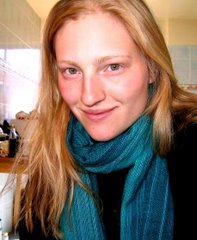So I’ve fallen in love with the area of town called “Sopocachi”. It’s a bit different from where I live (okay, a lot), in that it’s definitely a place with more money and more foreigners. You can see it on the streets as you’re walking - much more of a diverse crowd (aka not everyone looks of Andean origin), more stores that cater to “western tastes,” like a French fusion restaurant, a furniture store, and lots of internet cafes. But mostly it’s that the buildings are more colorful and there are a few trees spattered here and there. It's a toss up for me on where I think the "right" place to live would be - I know that where I live now is closer to the heart of La Paz (if you will), as it houses a mostly indigenous, working class population. But as a new arrival (not to mention the fact that I'm pretty much on my own in a neighborhood that is foreign in every aspect), I feel more comfortable in a more western, comfortable environment. On the upside, living where I am now is like a crash course in La Paz life...get on the mini-bus, yell when you need to get off, don't get hit by a car crossing the street, hail a radio taxi and repeat, "yes, Cruce Villa Copacabana" four times, just to make sure.
But this area Sopocachi: apparently it was built towards the beginning of the 20th century to house the growing population of richer people and foreigners, who now live in the suburban area called the “zona sur”, which is fascinating in and of itself. While Sopocachi appears to be a normal, if not a bit ritzy Bolivian neighborhood, the Zona Sur is apparently modeled after the American Suburb – it’s cut off from the rest of the city, and filled with huge single-family mansions, gated and surrounded by gardens, that often include an array of chola servants. It has its own supermarkets, people get around by driving SUVs, you name it. How interesting (ironic?) is it that the richer people of Bolivia model their homes after the middle-class American dream of the 1950s?
Today I wandered around a place referred to as the “mercado negro” and perhaps the “mercado chino” (okay, I’m still not familiar enough with the city to know the difference between street market areas). It’s a zig-zag of streets holding a sprawling market of stalls and indoor areas crammed with anything (seriously) you could ever think to buy. It’s actually separated spatially by the different types of goods that are sold, for example clothing vs. electronics vs. paper goods vs. household items. The “mercado chino”, which I think is just one part of this giant market area, is basically a black market selling all manners of stolen goods that some poor tourists were unfortunate enough to lose. I’d love to take pictures of the place, but something tells me that if I whipped out my camera and played the part of the obvious tourist, I would end up leaving the market with a lot less values then when I came. It’s a fascinating place, definitely a bit off the main drag, and once my Spanish is a bit more manageable I intend to go back and bargain for some important things...like a space heater. Hace mucho frio por aqui.
lunes, 25 de junio de 2007
Suscribirse a:
Comentarios de la entrada (Atom)

2 comentarios:
Sounds pretty amazing. I say you explore that more. I hope you hear back from volunteering places soon. All I have seen so far is the airport and my guesthouse, which is all of a minute drive away from the airport. But I have been speaking spanish (casi bien) and sort of understanding what people are saying to me. Buena suerte y hablamos pronto!
Had to catch up on your adventures. Last I heard until last night you were still working on the passport issue - am I behind or what! Look forward to hearing more about your travels and hope you're feeling better soon!
Publicar un comentario